
Introduction
A recent evaluation of Oregon Workers’ Compensation claims and Oregon Occupational Injury and Illness Survey cases suggests that workers who are injured on the job are returning to the workplace sooner. In addition to early-return-to-work programs, legislative changes resulting in increased safety awareness and changes in the definition of compensability have decreased the number of accepted disabling claims in recent years.
Workers' Compensation Claims
The Workers’ Compensation Division of the Oregon Department of Consumer and Business Services receives notification of occupational injuries and illnesses from insurers. A disabling claim excludes temporary disability suffered during the first three calendar days after the employee leaves work as a result of the injury or illness, unless the employee is an inpatient in a hospital. Nondisabling claims include occupational injuries and illnesses which result in three or fewer days of missed work. Reports of occupational injuries and illnesses are filed with the employer’s insurance company. The insurer is required to report every claim of disabling injury or illness to the division within 21 days after the employer has notice or knowledge of such injury or illness. However, nondisabling claims are not required to be reported to the division. Because only a portion are received by the division, the number of nondisabling claims is estimated.
Disabling vs. nondisabling claims
The recent history of Oregon’s workers’ compensation system can be divided into two periods. Prior to 1989, the trends in the total number of workers’ compensation claims were exaggerated versions of Oregon’s economic trends (Figure 1). The total number of claims fell dramatically when employment growth slowed in the early 1980s. This is due in part because less experienced workers tend to be laid off before experienced workers. Oregon’s workers’ compensation system was overhauled between 1987 and 1990 by legislative reforms (HB 2900 and SB 1197). These reforms improved the emphasis on safety and changed the definitions of compensability (a detailed description of these changes is available in Summary of Workers’ Compensation Claims Characteristics, Oregon, 1976-1996).
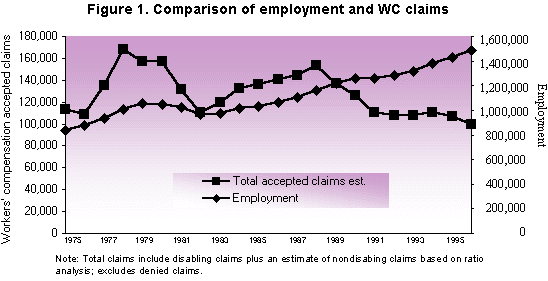
The trend changed between 1988 and 1996 when the number of workers covered by Oregon’s workers’ compensation law increased 28 percent and the total number of accepted claims decreased 35 percent. Because the total number of accepted claims includes accepted disabling claims (ADCs) received and an estimate of accepted nondisabling claims based on the number of ADCs, all three figures decreased 35 percent during this period. The significant decrease in the number of accepted disabling claims suggests a trend toward fewer days of missed work. Denied nondisabling claims continued to increase even though accepted claims began to decline (Figure 2). The number of denied nondisabling claims more than doubled between 1988 and 1996. However, the number of denied disabling claims remained relatively constant after SB 1197, followed by a 20 percent decrease between 1992 and 1993. As a result, the total number of denied nondisabling claims increased significantly, while the number of denied disabling claims decreased slightly. Therefore, the overall trend for denied claims has also been toward fewer days of missed work.
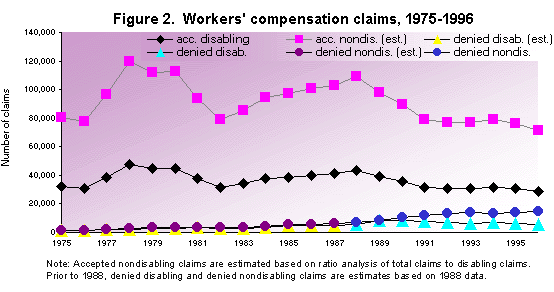
Oregon Occupational Injury
and Illness Survey
The Oregon Occupational Injury and Illness Survey utilizes data collected from a scientifically selected sample of private and public sector employers. These employers maintain a log and a supplementary record of occupational injuries and illnesses. Injuries and illnesses that meet recordkeeping guidelines for the survey include fatalities, and cases with lost workdays, or medical treatment. Lost workday (LWD) cases involve days away from work and days of restricted work activity. Days away from work are those days when an employee would normally have worked but could not due to an occupational injury or illness. Days of restricted work activity include days after the injury in which the employee is transferred to a temporary job, is unable to perform some of the regular duties of his or her permanent job, or is unable to work full-time at his or her permanent job.
Lost workday vs. days away from work cases
Between 1988 and 1996, the total number of LWD cases declined 11 percent, while the portion of these cases involving days away from work declined 23 percent. The growing difference between LWD cases and cases involving days away from work represents a growth in cases involving restricted work activity. Figure 3 illustrates these changes. This trend supports the theory that workers are returning to the workplace sooner after suffering occupational injuries or illnesses by returning to restricted work activity rather than taking days away from work.
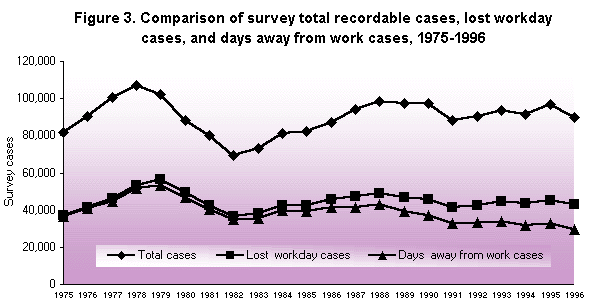
Correlation Between Disabling
Claims and Days Away from Work Cases
Figure 4 shows a strong correlation between the number of accepted disabling workers’ compensation claims and the number of survey cases involving days away from work. Since 1980, these two data sets have followed each other very closely. A graph of the accepted disabling claims rate (number of claims per 100 workers) and the days away from work case rate (number of cases per 100 workers) also shows a strong correlation between data sets (Figure 5). Changes in the number and rate of accepted disabling claims have paralleled changes in the number and rate of days away from work cases. The similarities between these two data sets support the theory that the decline in the number of ADCs can be explained in part by the fact that employers are returning injured workers to the workplace sooner, thereby avoiding having some claims become disabling.
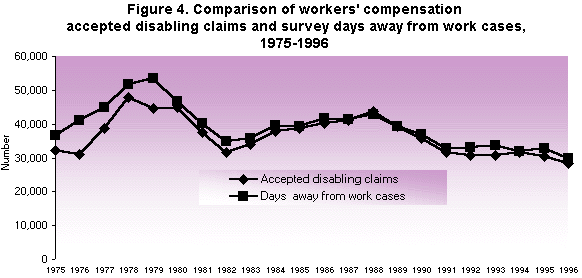
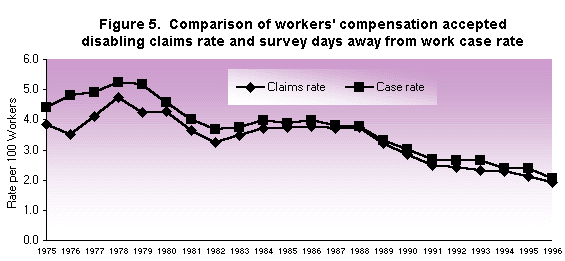
Employer-at-Injury Program
The Employer-at-Injury program is a package of financial incentives to Oregon employers to develop early-return-to-work programs for workers injured on the job. This program, which helps employees return to temporary, modified work at the earliest feasible date, may be helping to reduce the number of injuries that become classified as disabling. During its first year (1993), the program helped 447 disabled workers return to work early. Preliminary data shows the program helped 8,348 disabled workers return to work early in 1997. Beginning in 1996, the program was expanded to include nondisabling claims. In 1996 and 1997, 4,380 workers with nondisabling claims began an early-return-to-work program in the first six days after their date of injury. Sixty-four percent of these workers began the program either on the day they were injured or during the two days following their injury. Had these employees missed more than three days before returning to work, the status of their workers’ compensation claim would have changed from nondisabling to disabling. Therefore, the employees who return to work during the first two days after their date of injury offset the number of disabling claims.
Decline in Accepted Disabling
Claims
There are several explanations for the 35 percent decline in accepted disabling claims between 1988 and 1996. Improvements in workplace safety were achieved through better awareness of safety issues and increased penalties against employers who violated the state safety and health act. Safety and health loss prevention programs were required of insurers and self-insured employers. Employers with more than 10 employees, and smaller employers with high lost-workday incidence rates or high premium classifications were required to establish safety committees. Furthermore, SB 1197 changed the definitions of compensability for occupational injuries and illnesses, making it more difficult for some occupational injuries and illnesses to be defined as compensable (these changes are described in Summary of Workers’ Compensation Claims Characteristics, Oregon, 1976-1996). A decline in the number and/or severity of workplace accidents leading to injury or illness was observed after these legislative reforms were put into effect.
In addition to increased safety awareness and changes in the definitions of compensability, early-return-to-work programs are helping injured employees return to the workplace sooner. When early-return-to-work programs assist employees by returning them to work during the first two days after their date of injury, these programs help decrease the number of accepted disabling claims.